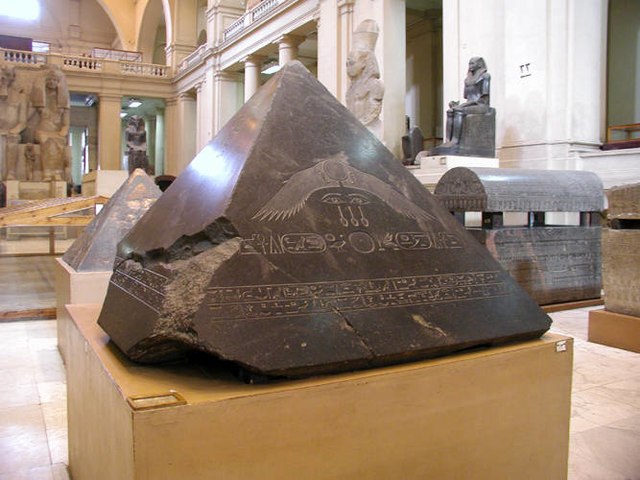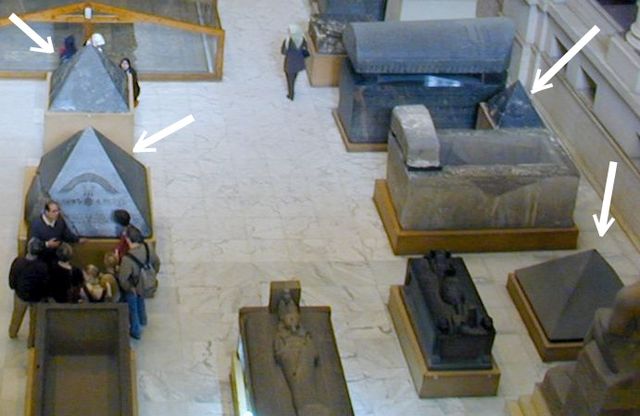Top Qs
Timeline
Chat
Perspective
Pyramidion
Capstone of an ancient Egyptian pyramid or obelisk From Wikipedia, the free encyclopedia
Remove ads
A pyramidion (plural: pyramidia) is the capstone of an Egyptian pyramid or the upper section of an obelisk.[1] Speakers of the Ancient Egyptian language referred to pyramidia as benbenet[2] and associated the pyramid as a whole with the sacred benben stone.[3]

Pyramidia were usually made of limestone, sandstone, basalt or granite,[4][5] and were sometimes covered with plates of copper,[6] gold or electrum.[3][7] From the Middle Kingdom onward, they were often "inscribed with royal titles and religious symbols".[3]
Remove ads
Notable pyramidia

Egyptian Museum
Four pyramidia are housed in the main hall of the Egyptian Museum in Cairo:
- The pyramidion of the so-called Black Pyramid of Amenemhat III at Dahshur[8]
- The pyramidion of the Pyramid of Khendjer at Saqqara
- The pyramidion of Merneferre Ay, probably from Saqqara[9]
- The pyramidion of the Southern South Saqqara pyramid
Red Pyramid

A badly damaged white Tura limestone pyramidion, thought to have been made for the Red Pyramid of Sneferu at Dahshur, has been reconstructed and is on open-air display beside that pyramid; it presents a minor mystery, however, as its angle of inclination is steeper than that of the edifice it was apparently built to surmount.
Washington Monument
Erected in 1876 in Washington D.C., the Washington Monument holds an inscribed pyramidion of aluminum.
Remove ads
Private brick pyramids with pyramidia
Summarize
Perspective
During the New Kingdom, some private underground tombs were marked on the surface by small brick pyramids that terminated in pyramidia. The four lateral sides included texts and scenes related to the cult of the Sun God (as the representation of Pharaoh).
The scenes typically depict the course of the sun, rising on one lateral face, setting on the opposite face, and traveling, through the night, through the underworld, ruled by Osiris.
Scribe Mose pyramidion
The pyramidion of Mose (mes, New Kingdom, 19th Dynasty, c. 1250 BC, limestone, 53 cm tall) depicts himself making an offering, with his name on two opposite faces. The adjacent opposite faces feature a baboon: "Screeching upon the rising of the Sun, and the Day". (The baboon is also the god-scribe representation of the Scribe, for the god Thoth.)[10]
Ptahemwia pyramidion
The pyramidion of Ptahemwia (19th Dynasty, Ramesside Period, c. 1200 BC, limestone, 28 cm wide, 42 cm tall) likewise displays sun-related scenes.[8]: 252 The Sun God, Re-Horakhti, and the god of the Underworld, Osiris, are shown on one lateral face.
Facing the two gods, on the adjacent lateral face, is the deceased Ptahemwia, standing in an offering pose, facing three columns of hieroglyphs.[8]: 252
Gallery
- Pyramidion of the chapel of Nesnubhotep, limestone with relief of a scarab and adoring baboons, 26th Dynasty, Abydos
- Pyramidion of Nebamun, limestone, 19th Dynasty, probably from Deir el-Medina
- Private tomb limestone pyramidion, at the Rosicrucian Egyptian Museum
- Pyramidion from the tomb of the priest Rer in Abydos, Egypt. Hermitage Museum
- Pyramidion of Ramose, from Deir el-Medina, 1292–1190 BC (New Kingdom), limestone, Museo Egizio, Turin
Remove ads
See also
- Washington Monument, which has an aluminum pyramidion
References
External links
Wikiwand - on
Seamless Wikipedia browsing. On steroids.
Remove ads





